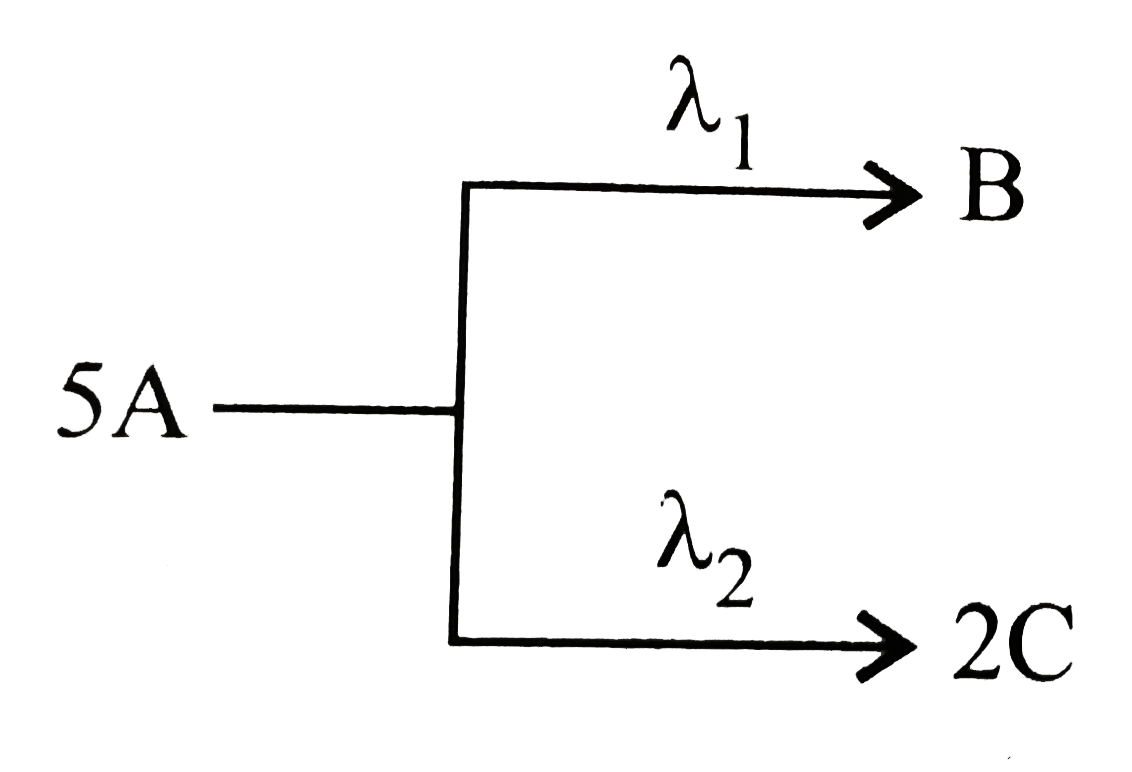A follows parallel path first order reaction to give B and C as given below (Take antilog (0.156)=1.428)

Initial conc of A is 0.2 M
The overall rate constant of the reaction is Solution in Telugu
2×10−5sec−1
1.5×10−4sec−1
5×10−6sec−1
b or c
The correct Answer is:A

K=K1+K2=(1.5×10−5+0.5×10−5),K+2×10−5
Topper's Solved these Questions
- CHEMICAL KINETICSBook:AAKASH SERIESChapter:CHEMICAL KINETICSExercise:PRACTICE SHEET-4 (MATCH THE FOLLOWING QUESTIONS)
Explore 2 Videos
- CHEMICAL KINETICSBook:AAKASH SERIESChapter:CHEMICAL KINETICSExercise:PRACTICE SHEET-4 (INTEGER ANSWER TYPE QUESTIONS)
Explore 6 Videos
- CHEMICAL KINETICSBook:AAKASH SERIESChapter:CHEMICAL KINETICSExercise:PRACTICE SHEET-4 (SINGLE OR MORE THAN ONE OPTION QUESTIONS)
Explore 16 Videos
- CHEMICAL KINETCSBook:AAKASH SERIESChapter:CHEMICAL KINETCSExercise:EXERCISE - 3.2
Explore 45 Videos
- CHEMICAL THERMODYNAMICSBook:AAKASH SERIESChapter:CHEMICAL THERMODYNAMICSExercise:Additional Practice Exercise
Explore 54 Videos
Similar Questions

View SolutionThe concentrationfo R in the reaction R→P was measured as a function of time and the following data is obtained:
[R] (molar) 1.0 0.75 0.40 0.10
t(min) 0.0 0.05 0.12 0.18
The order of the reactionis
View SolutionIn general the rate of a given reaction can be increased by all the factors except
View SolutionDiscuss on the kinetic spontaneity of a chemical reaction. Is a slow reaction spontaneous? Why?
View SolutionWhich among the following is not an exact differential?
View SolutionA follow parallel path of first-order reactions giving B and C as If the initial concentration of A is 0.25 M , calculate the concentration of C after 5 hr of reaction.
View SolutionFor a reaction between A and B, the initial rate of reaction is measured for various initial concentration of A and B. The data provided are {:("[A]","[B]","Initial reaction rate"),("(a) 0.02 M","0.30 M",5xx10^(-5)),("(b) 0.20 M","0.10 M",5xx10^(-5)),("(c) 0.40 M","0.05 M",1xx10^(-4)):} The overall order of the reaction is
View SolutionFor a reaction between A and B, the initial rate of reaction is measured for various initial concentrations of A and B . The data provided are :

The overall order of the reaction is :
View SolutionIn a first order reaction A → B, if k is rate constant and initial concentration of the reactant A is 2 M then the half life of the reaction is:
View SolutionA तथा B के मध्य अभिक्रिया के लिये, अभिक्रिया की प्रारंभिक दर को A तथा B की विभिन्न प्रारंभिक सांद्रताओं पर मापित किया गया। उपलब्ध आँकड़े इस प्रकार हैं

अभिक्रिया की सम्पूर्ण कोटि होगी
View SolutionWhich of the following relation is correct for a first order reaction? (k=rate constant, r=rate of reaction , c=conc. Of reactat
View SolutionThe initial rates for gaseous reaction A+3BtoAB_(3) are given below [A](M)" "[B](M)" ""Rate(Msec"^(-1)) 0.1" "0.1" "0.002 0.2" "0.1" "0.002 0.3" "0.2" "0.008 0.4" "0.3" "0.018 order of reaction is
View SolutionA follows parallel path first order reaction to give B and C as given below (Take antilog (0.156)=1.428) The concentratio of A after 5 hours is
View SolutionA follows parallel path first order reaction to give B and C as given below (Take antilog (0.156)=1.428)

At any stage of reaction molar yield of B in the products is
View SolutionA follow parallel path of first-order reactions giving B and C as
If the initial concentration of A is 0.25M, calculate the concentration of C after 5 hr of reaction.

View Solution

